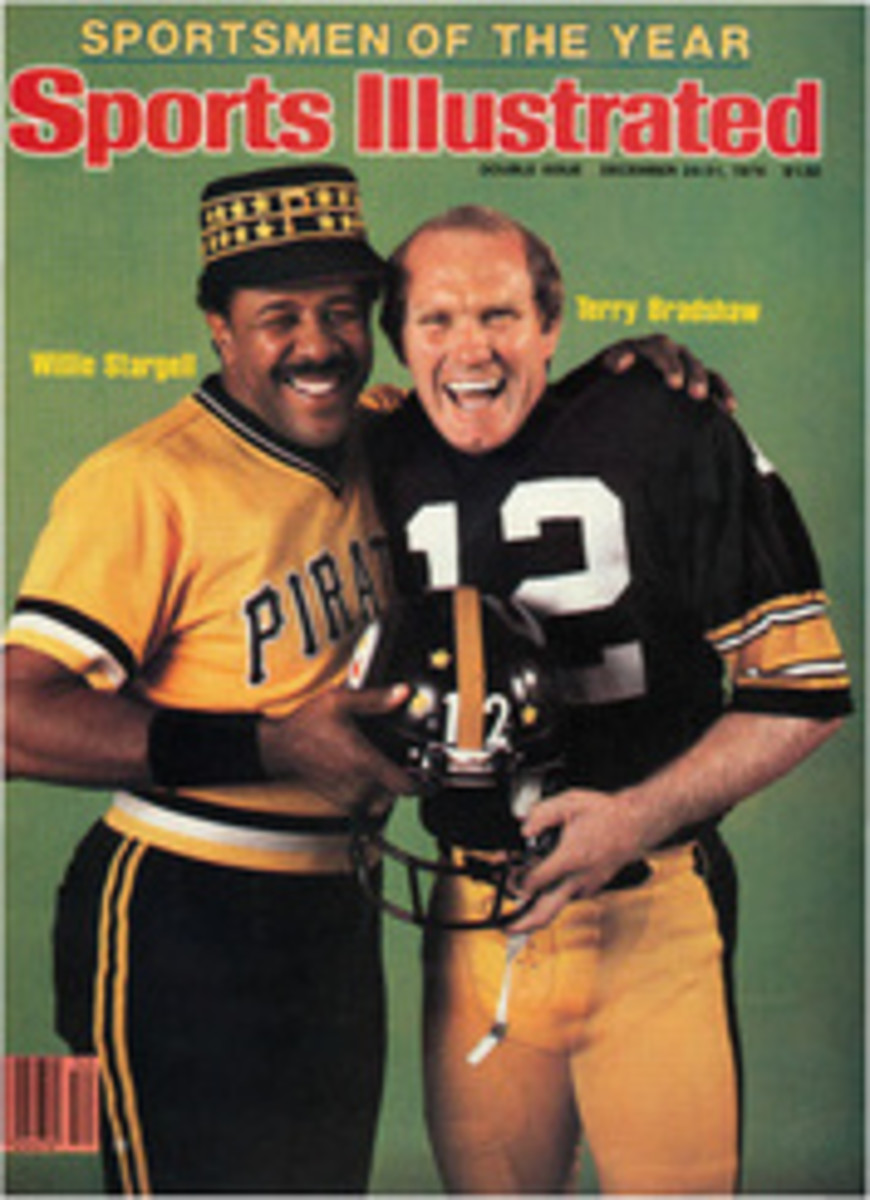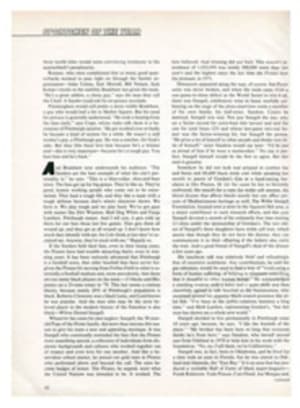
FOOTBALL GAMES ON PALISADO GREEN OVERCAME MONUMENTAL DIFFICULTIES
In 1633 a shipload of settlers from Dorchester, Mass. sailed down the Connecticut River to the Farmington River and on to what now is Windsor, Conn. Their descendants still live there. In 1932 the townspeople voted to observe Windsor's 300th anniversary by putting up a monument to their ancestors, if the cost was reasonable. The only dissenters were we members of the Sunday Afternoon Football Club, but our mournful cries went unrecorded. None of us was old enough to speak up at a town meeting, let alone vote. Further, we were betrayed by our mothers, who were tired of scrubbing at grass stains and mending the torn knees of our breeches. The site chosen for the monument was Palisado Green, our football field. That alone was enough to make the adult vote solidly pro-monument.
Palisado Green was shaped roughly like an egg. Outlined by trees, it was about 60 yards across at the south end, bellying out gently to 70 or 80 yards as it rolled up a slight slope, then tapering to a dozen or so yards at the north end. It was carpeted with grass, which, after a couple of centuries of mowing and rolling, was at least as fine as the 18th green of a good golf club. It was perhaps 150 yards long from tree line to tree line.
Smack in the center of this magnificent lawn was where the town built its monument, a great, walloping slab of granite with a scalloped top and names like Allyn, Ellsworth and Wolcott chiseled into it. Shrubbery was planted around it, arborvitae and rhododendron. The whole mess was 10 yards long north to south and 10 yards wide and the centerpiece soared 28 feet into the air.
And there, you might think, went our Sunday afternoon football games. Wrong. We adapted. The monument simply added new dimensions to our game, so to speak.
The game was touch football, and its few rules were vague and subject to debate. This, you must remember, was 1933, and the regimentation of children's play lay a generation ahead. The number on a side was elastic, as was age, ranging from kids of 7 or 8 to old men in their late teens. My brother Chas, for example, equaled all three Gunn brothers—Shot, Pop and Beebe. I equaled the two Anderson brothers, Dick and Normy, while Tony Vigiano equaled me plus the Andersons.
A note about Tony: he was a tawny-haired, blue-eyed, rosy-cheeked, cheerful chap, a barber much patronized by the grammar school set. His posted price for a haircut was a quarter, but if no parents were in evidence he always slipped each young customer a nickel refund, frequently recouping the nickel through the sale of a Baby Ruth candy bar from the big glass jar on the back counter.
Tony had lightning speed and quick moves, but he had poor hands and couldn't throw. The ball was rounder than it is today, and none of us could grip it. Throwing was a matter of balancing the ball on the palm of the hand, fingertips on laces, and hurling it with a sort of slinging motion. My brother Chas was the only one of us who could pass for any distance with accuracy.
Chas was short and squat, with thick arms and stubby fingers, but somehow he had mastered the knack of throwing the bloated football as far as 35 or 40 yards. His talent was largely wasted during our Sunday afternoon games, however, for I was the only player with any pass-catching ability.
Chas died a decade ago, but I see him on television several times each football season in the person of Bum Phillips, the coach of the Houston Oilers. Phillips is bigger all over, but put a cowboy hat on Chas, sit him next to Bum on the bench and, so help me, you couldn't tell them apart. Same jawline, same cheeks, same nose, same eyes in same setting, identical mouth and even the same type of glasses. The first time I saw Bum I damn near had a heart attack.
Before the incursion of the monument, our game was one of speed and elusiveness. Each team had four downs in which to cover the 150-yard length of the field and score a touchdown. Three downs, really, for the fourth was a kicking down and offered scoring opportunities. The team with the ball had to announce whether it was going to kick or run on fourth down. An announced kick could be made unmolested, but the receiving team had to be given time to station its members behind the trees to try to catch the ball. A punt that cleared the trees at the end of the field was worth one point if it dropped uncaught. A dropkick not caught by the defenders was good for three points. A touchdown, of course, was six points.
None of us had any equipment, so there was no blocking. Corduroy knickers, sweatshirts and sneakers were our uniforms. Once I tried to play wearing track shoes, but got howled down.
Strategy and tactics depended upon personnel. Tanglefoots such as the Gunn and Anderson boys played a sort of precursor to the zone defense. Giant Emerson Welch—six feet tall and growing at the age of 12—was a natural for charging into the offensive backfield. So was Roger Wessel, who was fast off the mark. Billy Braman and Wilfrid (Sap) Greenwood chased the ballcarrier. Tony Vigiano, Stan Klein, Carl Hodgdon and I played outside defensively to turn plays in, while Chas and Bobby Jones, scion of Windsor's only black family, usually defended as free safeties.
On offense, Chas and Tony were the tailbacks. By unspoken agreement, they always were on opposing teams. The rest of us were drawn from the pool of availables when sides were chosen, with the Gunn and Anderson brothers going as units. If one team proved too strong, a mid-game swap took place; Bobby Pfunder, say, for the Andersons, or Emmy Welch for Sap Greenwood.
One pre-monument play could be classed as typical of our game. We're running downhill, with about 130 yards to go. I'm the stand-up center, with Chas the tailback set about four yards back. I underhand the ball to Chas. Emmy Welch and Bobby Pfunder rush him. Chas tosses the ball to me. I cut left, running at three-quarter speed, easily dodging around Beebe Gunn, who obligingly falls down in front of brother Shot, who trips over him. I turn on full speed, heading for the easy boundary, where Tony is drifting along ahead of me, keeping the cutoff angle.
Meanwhile, Chas has ducked between Welch and Pfunder and is sprinting downfield behind and about a dozen yards inside me. Just as Tony closes in, I turn and flip a two-handed, end-over-end pass to Chas, giving him a good lead. He takes the ball in stride and cuts sharply toward the center of the field, making Bobby Jones overrun him. The remaining Gunn boy, Pop, is standing there, not quite sure what is happening but knowing enough to take a swipe at Chas, catching him on the shoulder. The play should have gone for a touchdown; similar plays often did. But a 50-yard gain ain't bad. We'd take it anytime.
That was pre-monument. The monument changed everything. Guile became as important as speed and agility, especially on kick returns.
The first thing a kick returner did was head for the monument, and it was any defender's guess whether he would burst wide, cut close to the monument, or, while hidden behind it, reverse his field or hand off to a teammate going the other way. Of necessity, the defenders had to split their forces, sending half their players down each side of the monument, with those on one side unable to see what those on the other side were doing.
A trick that worked for me once brought me much quiet joy, then and in retrospect. I caught a Welch punt about 15 yards from the monument, dashed full tilt for its cover, then, hidden behind the shrubbery, stopped dead. Defenders came thundering past me on both sides, and all I had to do was take off for the goal line with nobody in front of me.
In time, all players except the Gunns and Andersons learned to use the monument, both for cover on offense and as an immobile defender. Then Chas came up with the play that blew all past tactics off the field.
It was Chas' play, but typically, because Chas was a scholar, he got the idea from a book. This happened almost half a century ago, and I don't remember whether the book was Dink Stover At Yale, or the one about Knute Rockne and Gus Dorais. Whichever, the book told how passer and receiver spent a whole summer working out a spot-pass count system.
We didn't spend a summer, but Chas got me out on Palisado Green one October evening, practicing his play until dusk turned to dark and my hands were too numb to catch the ball. We used the play that Sunday, and the memory is as vivid as that of the unforgettable day my son pitched a no-hitter.
For this play we lined up differently. Chas played center. Sap Greenwood was at tailback and I lined up at right end. Chas lobbed the ball to Sap, and I took off downfield, running with everything I had, and counting.
One thousand and one, one thousand and two, and I was past the Anderson boys and Joey Moran. One thousand and three, and I was at the upper end of the monument, with Bobby Jones running alongside me. One thousand and four, and I was at the far end of the monument and cutting toward it as Jones turned back to guard against a run. He knew that in another stride or two I'd be behind the monument and safely out of the play. I was all alone, running with glorious speed, piercingly aware of the crisp air scented with burning leaves, the green grass and hazy blue sky.
One thousand and five.
Meanwhile, upheld Sap Greenwood had tossed the ball back to Chas, who took a few quick steps to his right while counting. He put his stubby fingers on the laces of the ball, and when his count reached one thousand and four, reared back and flung the ball with all his might right over the center of the monument.
I saw none of this, but I knew it was happening. When the count reached five I stretched out my arms and looked back over my left shoulder toward the top of the monument. Sure enough, outlined against the sky and spiraling down toward me came the football.
The catch was automatic, and I trotted through the trees for a touchdown while the defenders screamed "Foul!" and wondered just how such a miracle could happen.
The over-the-monument pass worked a few more times in the next couple of weeks, but that was all. The consensus was that the Smiley Brothers Aerial Circus was unfair, and Chas and I never were allowed to play on the same team.
The Sunday Afternoon Football Club lasted another season, then time did what the monument could not. Chas went off to college, Tony got married, and the Gunn brothers moved to Chicago or Kansas City or some such place. Emmy Welch became interested in, for heaven's sake, girls! Bobby Jones decided to take music seriously, Normy Anderson went to work in a gas station, and I—well, I played touch football off and on for the next few years before moving up to tackle, but the glory days of boyhood were over. There were no more passes over the monument.
ILLUSTRATION

